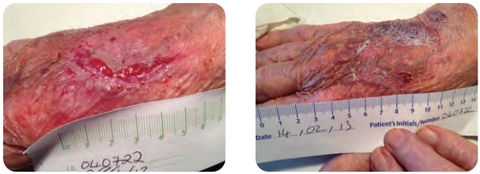The use of Silflex and Advazorb Silfix on a laceration to the hand
Written by: Lorraine Bell - Staff Nurse, Auchterarder, NHS Tayside
Introduction
KS is a 91 year old gentleman who lives alone. He is in good health for a man of his age but becoming increasingly frailer. His skin is friable due to age and certain medications. He is prone to falls and bumps. His most recent laceration (approx 4cm in length) was sustained from a bump to his hand.
Due to the fragility of skin it was important to choose a dressing which would not cause trauma on removal but also a practical dressing for this area.
The wound was clean and free from signs of infection therefore the decision was made to use Silflex (soft silicone wound contact layer) and Advazorb Silfix (hydrophilic foam dressing with soft silicone wound contact layer). Dressings were changed twice weekly and were free from trauma due to the nature of these dressings. Alternative dressing choices would have been Mepitel and Mepilex which at the time were approximately 30% more expensive. Using Advazorb Silfix gave the added benefit of being able to lift and replace the same dressing to monitor wound progress, especially in the latter stages of healing. Silflex was left undisturbed on the wound and changed weekly, allowing the wound to be observed and cleansed.
The wound continued to make good progress with each dressing change and was healed relatively quickly. Dressing changes were cut down to once weekly using Advazorb Silfix only for the last 2 weeks. The dressings were secured with a Tubifast type dressing to prevent it from being disturbed.

